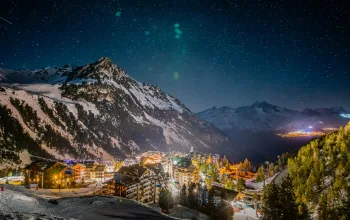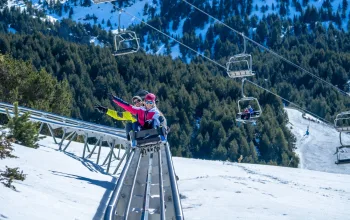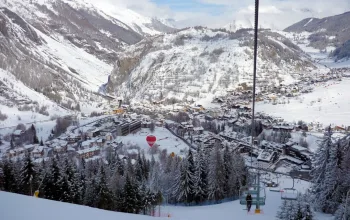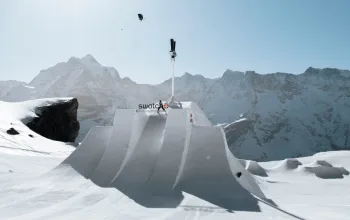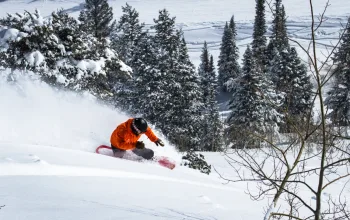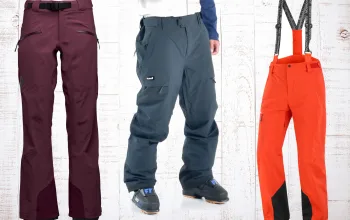There are many reasons to choose a particular ski destination – it’s cheap, the flights are easy, it has world-beating après – but the best reason has to be that you love its mountain. There’s something mysterious and alluring about the mountain that my friend Pete and I have chosen for our short break to Switzerland.
Many things recommend the Jungfrau region, home to the traditional resorts of Grindelwald, Wengen and Murren, to skiers. It has the grit of a ‘real’ place, thanks to mountaineering and farming communities that live in its old Swiss towns all year round – skiers shoosh past cattle stands, and bars are full of hardy locals who bivouac at 3,000 metres. It has the Lauberhorn, the longest downhill ski race in the world (4.5km), and such a regular feature of Ski Sunday that every wild bend and high-speed straight (it has both the fastest and slowest sections of any downhill race) is burned into our memories. It has trains that don’t just run up and down the mountain but through it. There’s something very Swiss about that, engineering highly punctual rail systems big enough to move towns full of skiers up a 2,000 metre mountain without building a single switchback road to scar the snow. It also has more than 200km of slopes and 60km of tobogganing. But what really does it for us is the Eiger, a mile-high escarpment of rock that has defied and challenged climbers since the 1930s and is, as far as Pete and I are concerned, positively the most interesting rock in the world.
The first thing we do when we arrive is stand beneath it. It’s dark, there’s a full moon, and we can hear the fading shouts of beery toboganners disappearing into Grindelwald, lit up like a wonky flattened Christmas tree in the valley below. We walk up a piste trailed by our moon shadows and the Eiger looms above, brutal, majestic, the moonlight picking out the legendary stages of the climb up it – the Traverse of the Gods, the White Spider, the summit. It’s so high and silent, I feel sick coming up to it. From here, three big regions are ours to ski – Grindelwald, Wengen and Murren, all known for picturesque vistas – but we both know that over the next two days we’ll mostly be drawn to the mountain.
The next morning we’re out and on the slopes before the cuckoo can get out of its clock. The sun is shining and we’re treated to perfect spring skiing conditions – all the better to be the first people on the Lauberhorn. We wedge ourselves into the starting shed and Pete peeps out, knees against the gates, skis balanced on the edge. A passing Swiss woman hollers ‘1,2,3’ and he’s off, gates flapping, if not quite Bode Miller, at least moving at some speed, which is more than can be said for me. I come much closer to stopping than to anything that could be called my limit. This is my first run of the season, but soon I’m hitting my stride and we carve big turns into the huge empty piste which rolls out in front of us. Miller makes 150km per hour on these slopes. Pete clocks 109km per hour. I hit 73km per hour, but considering I’m locked in a permanent snow plough and constantly trying to stop, it’s not bad going.
We ski through a wood, past some cowsheds and drop into town where everyone is getting up for their first train of the day. The snow is hardpacked and the runs fairly empty, so we ski and ski and ski, stopping for lunch outside a little mountain hut that serves bowls of soup under a Swiss flag (with, crucially, a view of the Eiger) and then ski and ski and ski some more, traversing right underneath our favourite summit and doing powder eights back to the piste, finishing the day in a bar. We end up drinking beer with a man called Johann who tells us tales of sleeping in slings suspended on the North Face, and winching up freezing and terrified climbers into helicopters.
Johann, it turns out, is a local climber and guide who works for mountain rescue. We soak up his stories of epic thunder and ice storms, high winds and ice falls. Then we switch bars and soak up most of the drinks menu, surrounded by pictures of brave, noble climbers in tweed. One of the charms of the Jungfrau is that it’s not just the snowclad mountains that remain unchanged for decades. The trains, the white beer, the wooden-shuttered chalets full of Swiss and English families on ski holidays and the alpine snowflake jumpers all stay reassuringly the same. Nostalgic for an era we never lived in, we toast our trip with Whisky Sour, Gin Fizz and a couple of Martinis. By the next morning we are such good friends with the snowboarding Argentinean barman Mario (cruising speed 115km per hour) that he takes us on an off-piste adventure. Once again, we’re first on the slopes and, chasing Mario down the Lauberhorn, we take a cable car from Wengen, then put our skis on our shoulders and walk to the top of Mandlichen-Gipfel, a 20-minute climb on a surface that varies between powder and light crust.
Mario generally does this about three times before his morning shift. Pete and I practically die doing it once. At the top, it is almost heaven – clouds circle the top of mountains like smoke rings, the sun shines bright off the white snow, the valleys are full of clean air, steep rock and fir forests. Mario points out the massive glaciated faces of the Eiger, Monch and Jungfrau (the monk standing between the ogre and the virgin or young girl – the jungfrau) and then shoots off, while I try to stay on the half-powder, half-crust and out of the sheer drops down to the valley, which bristles with green fields and haystacks 2,000m below. At 11am Mario leaves us refuelling on rösti, hysterical with tiredness.
We pull out our piste maps, wondering what to do next. ‘We could go to Murren-Schilthorn, which has a 12km black Inferno run than descends 2,000 metres to Lauterbrunnen (itself home to 72 waterfalls, some likely to still be frozen)…’ ‘We could break out and go to Grindelwald, but it’s a bit intermediate and family-friendly…’ And then, right above my plate of cheese toasties, and to the left of Pete’s head, I spot the White Spider shining down at me. ‘I mean there are 19 lifts over there, Pete, and 110km of ski runs, we could just go back and hang about under the Eiger….’.
Snotes
Kate Rew stayed at the Bellevue des Alpes by Kleine Scheidegg, the only hotel located at the train station rather than in the valleys of Wengen, Murren or Grindelwald below, giving guests unparalleled access to early morning skiing.
Getting there:
Swiss (swiss.com), British Airways (ba.com) and EasyJet (easyjet.co.uk) all fly to Zürich airport. From there Switzerland’s ruthlessly efficient rail system (MySwitzerland.com/rail) delivers skiers to the various Jungfrau resorts in between 2hrs 45 and 3 hrs 30. Road transfers take between two and two and a half hours
Snotes
Tour operators:
High-end: Powder Byrne (powderbyrne.com)
Mid-range: Switzerland Travel Centre (stc.co.uk)
Budget: Crystal (crystalholidays.co.uk)
Season dates: Dec 2009 – April 2010
Vertical drop: 2,970-795m
Terrain: 213km
Snowmaking: 50%
Mountain munchies: There are numerous cosy mountain restaurants, bars and open-air shacks on the slopes and by Kleine Scheidegg train station. If you want to go old-school have lunch at the Bellevue des Alpes just above the train station (a banquet table carved out of snow is covered in a tablecloth and silver platters). And for those with a James Bond fixation a train can be taken up to the Piz Gloria rotating restaurant which serves a ‘007 Breakfast’ before skiing down the Shilthorn area.
Guiding and tuition: Plenty of options in each town.
Snowpark?: Yes
Downtown: Grindelwald is the hardest partying of the Jungfrau towns, with lots of local bars, Wengen is a classic Swiss winter resort and Mürren is the smallest. All three are family friendly.
Highlight: The hotel Bellevue des Alpes – Victorian baths with views of the mountains, wood-panelled bars serving the best martinis and dinner on the family silver. A flawless old-school hotel at an old-school price.
Bummer: At 2-3.5 hours away Zürich is maybe a little too far to make this ideal for a short break.
Images: shutterstock.com, Images: Kate Rew



 Hypnotised by the might of the towering Eiger, Kate Rew finds challenging slopes, moreish cocktails and a slice of immaculate old-school hospitality in Switzerland’s stunning Jungfrau region.
Hypnotised by the might of the towering Eiger, Kate Rew finds challenging slopes, moreish cocktails and a slice of immaculate old-school hospitality in Switzerland’s stunning Jungfrau region.